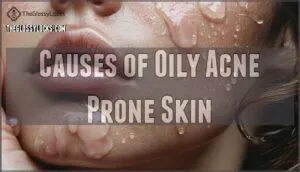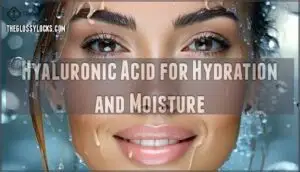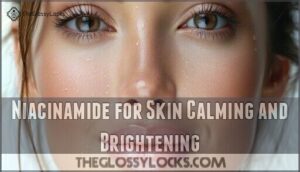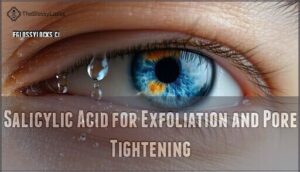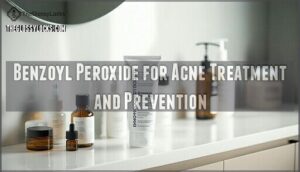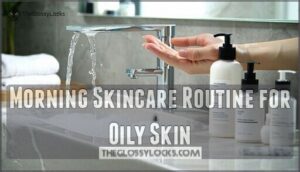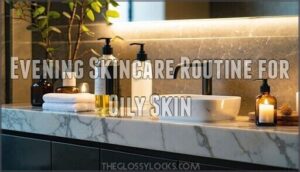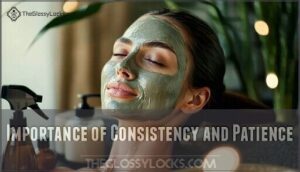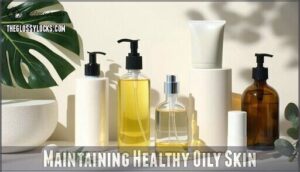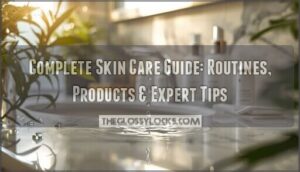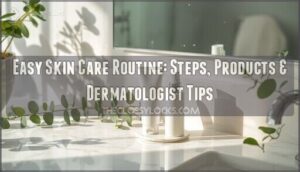This site is supported by our readers. We may earn a commission, at no cost to you, if you purchase through links.
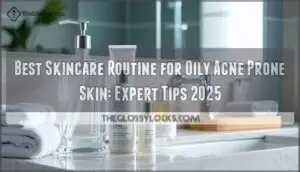
You’ll want to follow up with a lightweight, non-comedogenic moisturizer containing hyaluronic acid or niacinamide to maintain your skin barrier without clogging pores.
Don’t skip sunscreen—zinc oxide formulas work best for acne-prone skin.
At night, consider adding a retinol treatment to boost cell turnover.
The key isn’t stripping your skin bare; it’s finding that sweet spot between oil control and proper hydration. Your sebaceous glands actually produce more oil when they’re dehydrated, creating a frustrating cycle that proper routine management can break.
Table Of Contents
- Key Takeaways
- Oily Skin Care Basics
- Causes of Oily Acne Prone Skin
- Key Ingredients for Oily Skin
- 9 Best Skincare Products for Oily Skin
- 1. Ceramide Moisturizer Face Cream Lotion
- 2. acne treatment skin care kit
- 3. Benzoyl Peroxide Acne Face Wash
- 4. Gentle Facial Cleanser for Sensitive Skin
- 5. Gentle Facial Exfoliating Face Wash
- 6. Natural Oil Control Facial Toner
- 7. Salicylic Acid Facial Exfoliant Liquid
- 8. Retinol Serum For Acne Marks
- 9. Mineral Sunscreen With Zinc Oxide
- Creating an Effective Skincare Routine
- Maintaining Healthy Oily Skin
- Frequently Asked Questions (FAQs)
- What is the 4 2 4 rule in skincare?
- What is the best skincare product for acne oily skin?
- How to fix acne prone oily skin?
- What is best for oily skin with acne?
- What is the order of skincare routine for oily skin?
- What should I avoid if I have oily acne-prone skin?
- How do you skin cycle for oily acne-prone skin?
- How can hormonal changes affect oily skin?
- What role does diet play in oily skin?
- How do environmental factors influence oily skin?
- Conclusion
Key Takeaways
- Balance cleansing without stripping – You should not over-cleanse or use harsh scrubs that trigger rebound oil production; instead, use gentle salicylic acid or benzoyl peroxide cleansers twice daily to maintain your skin’s protective barrier.
- Hydrate to control oil production – You will need lightweight, non-comedogenic moisturizers with hyaluronic acid or niacinamide because dehydrated skin actually produces more oil, creating a frustrating cycle that proper hydration breaks.
- Layer active ingredients strategically – You cannot pile on multiple treatments at once; instead, introduce ingredients like retinol, salicylic acid, and niacinamide gradually to prevent irritation while maximizing their pore-clearing and oil-regulating benefits.
- Consistency beats intensity – You will not see results overnight, so stick to your routine for 6-12 weeks and resist the urge to pick at breakouts or constantly switch products when progress feels slow.
Oily Skin Care Basics
Managing oily, acne-prone skin requires understanding your skin’s unique needs rather than simply stripping away oil.
You’ll need to balance sebum control with proper hydration, since compromised skin barriers often trigger increased oil production and breakouts, which is crucial for maintaining healthy skin and achieving proper hydration.
Identifying Skin Type and Needs
Before you begin your skincare journey, proper skin analysis becomes your roadmap to success.
You’ll need to assess your oil control needs by observing how quickly your T-zone becomes shiny and evaluating your pore size throughout the day.
Check your moisture levels and hydration needs—oily acne prone skin often masks underlying dehydration.
This skin type identification process helps you choose targeted products for your skincare routine for oily skin, preventing the common mistake of over-treating already stressed skin.
Understanding your skin type characteristics is essential for creating an effective skincare routine.
Understanding Skin Barrier Function and Hydration
Your skin barrier acts like a protective wall, keeping moisture in and irritants out.
When this barrier gets damaged, your skin loses water faster than you can say "dehydrated mess."
For oily acne prone skin, compromised barrier function triggers overactive oil regulation – your skin produces more sebum to compensate for water loss.
This creates a vicious cycle where excess oil clogs pores while your skin still craves hydration underneath.
Importance of Gentle Cleansing and Balanced Skincare
Breaking free from harsh cleansing habits reveals your skin’s natural balance.
Gentle cleansing preserves your skin’s protective barrier while controlling excess oil production.
When you maintain proper skin pH and moisture balance, you’ll notice fewer breakouts and healthier-looking skin.
Your oily skin care routine should include:
- pH-balanced cleansers that won’t strip natural oils or trigger rebound sebum production
- Noncomedogenic moisturizers with lightweight formulas that hydrate without clogging pores
- Oil regulation actives like niacinamide that control shine while supporting barrier function
Causes of Oily Acne Prone Skin
Understanding what triggers your oily, acne-prone skin helps you choose the right products and routines for clearer results.
Your skin’s oil production stems from a complex mix of internal factors like genetics and hormones, plus external influences including weather, stress, and the products you’re already using, which can lead to clearer results when understood and addressed properly.
Genetic Factors and Hormonal Fluctuations
Your genes basically write your skin’s oil production blueprint.
Up to 85% of acne susceptibility comes from genetic predisposition, meaning if your parents battled oily skin, you’ll likely inherit similar sebaceous gland activity.
Hormonal fluctuations during puberty, menstrual cycles, and menopause trigger increased sebum control challenges, especially when androgen sensitivity runs in families.
Understanding the sebum production factors can help you develop a more effective skincare routine.
| Genetic Factor | Impact on Oily Skin |
|---|---|
| Sebaceous Gland Size | Determines baseline oil production levels |
| Androgen Sensitivity | Controls hormone response and sebum regulation |
| Inflammatory Response | Influences acne severity and skin reactions |
| Pore Structure | Affects clogging tendency and breakout patterns |
Understanding your skin inheritance helps explain why standard routines mightn’t work—your fluctuation management needs are uniquely yours, requiring personalized acne prevention strategies.
Environmental Factors and Lifestyle Choices
Beyond genetics, your environment and daily choices substantially impact oily skin management.
Air pollution clogs pores and disrupts skin pH balance, while climate change brings humidity fluctuations that trigger excess sebum control mechanisms.
Poor dietary habits, irregular sleep patterns, and inadequate stress management worsen acne prevention efforts.
You can’t control the weather, but you can shield your skin with proper sunscreen importance and consistent routines that work with your lifestyle, not against it, to achieve better skin management.
Key Ingredients for Oily Skin
When you’re dealing with oily, acne-prone skin, choosing the right active ingredients can make the difference between clear skin and constant breakouts.
The key is understanding which powerhouse ingredients actually work to control oil production, unclog pores, and prevent future acne without over-drying your skin, which is crucial for achieving clear skin.
Hyaluronic Acid for Hydration and Moisture
Hyaluronic acid transforms oily skin hydration by holding 1,000 times its weight in water without adding heaviness.
This powerhouse ingredient breaks the dehydration-oil cycle that triggers excess sebum production. Studies show it reduces oil gland activity while strengthening your skin’s protective barrier.
For ideal results, consider learning about hyaluronic acid benefits to enhance your skincare routine.
Hyaluronic Benefits for oily skin:
- Provides intense hydration without clogging pores or creating greasy residue
- Balances sebum production by signaling skin it’s adequately moisturized
- Accelerates healing of acne lesions while reducing post-breakout inflammation
Niacinamide for Skin Calming and Brightening
While hyaluronic acid tackles hydration, niacinamide (Vitamin B3) serves as your skin’s multitasking superhero.
This powerhouse ingredient regulates sebum production, making it perfect for oily skin management. Niacinamide benefits include reducing pore appearance and delivering impressive skin brightening effects.
Its calming properties help soothe irritated, acne prone skin while tackling hyperpigmentation. You’ll notice fewer breakouts and a more even complexion with consistent use.
For ideal results, consider using a niacinamide serum as part of your skincare routine.
Salicylic Acid for Exfoliation and Pore Tightening
Salicylic acid acts as your secret weapon against stubborn breakouts.
This oil-soluble powerhouse penetrates deep into pores, dissolving the gunk that clogs them.
Unlike surface treatments, salicylic acid works from within, breaking down dead skin cells and excess sebum.
You’ll notice tighter-looking pores and smoother skin texture with consistent use at 0.5-2% concentrations.
Benzoyl Peroxide for Acne Treatment and Prevention
Why shouldn’t acne-causing bacteria have the final say in your skin’s destiny?
Benzoyl peroxide acts as your skin’s superhero, delivering powerful antibacterial action that targets acne at its source.
This proven acne treatment penetrates deep into pores, eliminating bacteria while promoting skin purification.
For oily skin types, benzoyl peroxide works alongside salicylic acid to provide thorough acne prevention and oil regulation, creating clearer, healthier-looking skin.
Understanding the role of acne treatment options is essential in developing an effective skincare routine for oily acne-prone skin, using powerful treatments to achieve better results.
9 Best Skincare Products for Oily Skin
Finding the right products for oily, acne-prone skin doesn’t have to feel like solving a chemistry equation.
You’ll want to focus on gentle yet effective formulations that balance oil control with proper hydration to keep your skin barrier healthy.
1. Ceramide Moisturizer Face Cream Lotion
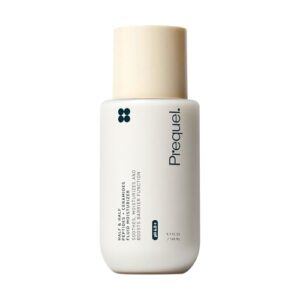
Breaking the cycle of oily skin frustration starts with understanding that moisture doesn’t mean more oil.
This ceramide moisturizer contains 1% dermo-mimetic ceramide NP in an olive-derived matrix, clinically proven to strengthen your skin barrier by over 30%.
The lightweight liquid emulsion delivers hydration without greasiness, actually signaling your skin to reduce sebum production over time.
Studies show it can decrease inflammatory acne lesions by 22% in eight weeks while maintaining 12-24 hour moisture retention.
Best For: People with oily, acne-prone, or sensitive skin who want lightweight hydration and a stronger skin barrier without extra greasiness.
- Strengthens the skin barrier and helps reduce environmental irritation.
- Lightweight texture hydrates without clogging pores or causing shine.
- Clinically shown to reduce acne lesions and maintain moisture for up to 24 hours.
- May not provide enough moisture for very dry or flaky skin on its own.
- Requires twice-daily, consistent use to see best results.
- Must remember to shake and prep the bottle before each use, which could be inconvenient.
2. acne treatment skin care kit
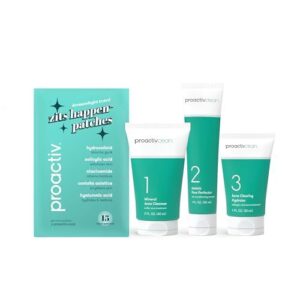
Within weeks of starting a thorough acne treatment kit, you’ll notice clearer skin and reduced breakouts.
Multi-step systems combining salicylic acid and benzoyl peroxide deliver clinical results – 94% of users see visibly clearer pores within fourteen days.
These dermatologist-formulated kits streamline your routine while preventing ingredient conflicts.
Look for systems including cleanser, treatment serum, moisturizer, and spot patches for maximum effectiveness against stubborn acne.
Understanding the causes of acne skin issues is essential for selecting the right treatment approach.
Best For: Those with mild or occasional acne and sensitive skin who want a gentle, non-irritating routine.
- Gentle formula suitable for sensitive, acne-prone skin, free from over 100 harsh ingredients.
- Multi-step routine targets blemishes, calms irritation, and smooths texture with sulfur, salicylic acid, azelaic acid, bakuchiol, and chamomile.
- Includes hydrocolloid patches for targeted spot treatment and protection.
- Not intended for moderate or severe, cystic acne—may be too mild for tough or persistent breakouts.
- No benzoyl peroxide, a proven ingredient for bacterial acne, in the formula.
- Requires consistent morning and evening use for best results, which may not suit everyone’s routine.
3. Benzoyl Peroxide Acne Face Wash
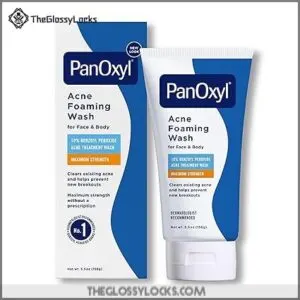
Consistently effective for stubborn breakouts, this 10% benzoyl peroxide wash delivers maximum over-the-counter strength antimicrobial action.
You’ll kill over 99% of acne-causing bacteria in just 30 seconds while lifting dirt from clogged pores.
The foaming formula works on your face, chest, and back to clear existing blemishes and prevent new ones.
Start slowly to avoid irritation—your skin needs time to adjust to this powerhouse ingredient, ensuring you can effectively use it to clear stubborn breakouts.
Best For: People with stubborn or severe acne on the face, chest, or back who need a strong, fast-acting solution.
- High strength can cause irritation, dryness, or redness, especially for sensitive skin.
- May bleach towels or clothing if not fully rinsed off.
- Not ideal for treating blackheads or mild, non-inflamed acne.
- Kills over 99% of acne-causing bacteria in seconds for quick results.
- Clears existing acne and helps prevent new breakouts.
- Suitable for multiple areas and contains moisturizing ingredients to combat dryness.
4. Gentle Facial Cleanser for Sensitive Skin
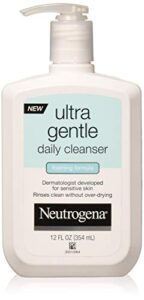
Many people with oily, acne-prone skin assume they need harsh cleansers, but gentle formulations often work better.
The Neutrogena Ultra Gentle Daily Cleanser offers soap-free, hypoallergenic cleansing that removes excess oil without stripping your skin’s natural moisture barrier.
Its patented technology effectively removes dirt and makeup while being clinically proven gentle for sensitive skin.
You’ll appreciate that it rinses completely clean, leaving no pore-clogging residue behind.
Best For: People with sensitive or oily skin who want a gentle, non-irritating cleanser that won’t clog pores.
- Soap-free, oil-free, hypoallergenic, and non-comedogenic formula won’t strip or irritate skin.
- Removes excess oil, dirt, and makeup effectively while protecting the skin’s natural moisture barrier.
- Rinses completely clean without leaving residue and works well with other skincare steps.
- Some users notice mild dryness after washing and recommend following with a moisturizer.
- Packaging can leak during shipping if not well-sealed.
- Fragrance-free, but some may still detect a light chemical scent.
5. Gentle Facial Exfoliating Face Wash
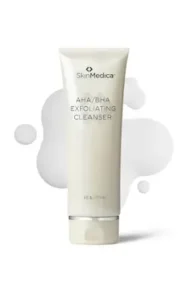
You’ll discover a game-changer when you find the right exfoliating face wash that works overtime.
Gentle formulas with salicylic acid or botanical extracts remove dead skin cells while preventing clogged pores.
Clinical studies show 79% of users saw fewer inflammatory lesions with herbal-based exfoliating cleansers.
Use 2-3 times weekly to avoid over-exfoliation, which can backfire and worsen breakouts.
Look for products containing alpha-hydroxy or beta-hydroxy acids paired with hydrating ingredients like glycerin to maintain your skin barrier.
Best For: Adults with sensitive, rosacea-prone, or mature skin who want gentle daily exfoliation without irritation.
- Improves skin tone and texture noticeably while remaining gentle and non-irritating.
- Reduces blackheads and fat deposits and works for both the face and body.
- Long-lasting tube; a small amount covers a lot, making the product cost-effective.
- Not moisturizing—using a separate moisturizer is necessary.
- Packaging issues reported, such as arriving with damaged or opened boxes.
- Higher price point than many standard face washes.
6. Natural Oil Control Facial Toner
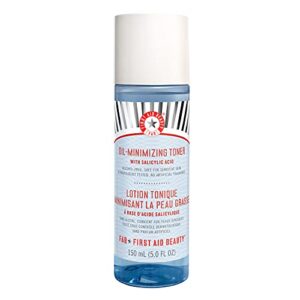
After your cleansing routine, a natural oil control facial toner works like a reset button for your skin’s balance.
The First Aid Beauty liquid toner delivers alcohol-free sebum regulation without irritation, making it perfect for sensitive oily skin types.
Clinical studies show toners containing witch hazel and tea tree oil reduce excess oil production while tightening pores and restoring healthy pH levels.
This gentle formula prepares your skin for moisturizer absorption while preventing that midday shine you’re trying to avoid.
Best For: Those with oily, sensitive, or acne-prone skin who want gentle oil control and improved skin texture.
- Alcohol-free formula controls oil without drying or irritating sensitive skin.
- Balances skin, shrinks pores, and preps skin for moisturizer.
- Easy to work into your daily routine, leaves skin matte and even-toned.
- Rare complaints about packaging or unsealed bottles.
- May not suit those who prefer richer hydration or have very dry skin.
- Results may vary; not all users notice dramatic changes in oiliness or pore size.
7. Salicylic Acid Facial Exfoliant Liquid

Your skin’s best friend in the fight against oily chaos, salicylic acid liquid exfoliant penetrates deep into pores like a molecular janitor.
This 2% BHA powerhouse dissolves excess sebum, unclogs stubborn blackheads, and reduces pore size within weeks.
You’ll notice smoother texture and fewer breakouts as it gently sheds dead skin cells.
Start every other night to avoid irritation, then increase frequency as your skin adapts to this pore-clearing champion, using it to achieve a smoother skin texture with fewer breakouts.
Best For: People with oily, acne-prone, or combination skin who want smaller pores and a smoother, clearer complexion.
- Unclogs pores and reduces blackheads quickly.
- Smooths rough texture and visibly shrinks enlarged pores.
- Gentle formula, fragrance- and paraben-free, works for sensitive skin.
- Can cause dryness or irritation if overused or used on very sensitive skin.
- Must use sunscreen daily, as it increases sun sensitivity.
- Higher price point compared to basic exfoliants, though it lasts a long time.
8. Retinol Serum For Acne Marks
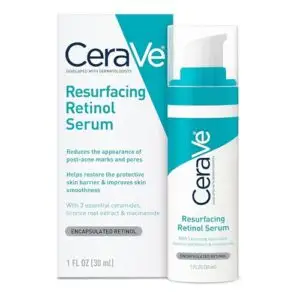
Post-acne marks don’t have to be permanent reminders of past breakouts.
Retinol serum accelerates cellular turnover and stimulates collagen production, effectively fading dark spots and smoothing texture over time.
Clinical studies show up to 91% improvement in acne scarring after 12 weeks of consistent use.
Start with once-weekly application to minimize irritation, gradually increasing frequency.
Always pair with sunscreen since retinol increases photosensitivity.
Expect initial purging before seeing clearer, more even-toned skin.
Best For: People with post-acne marks, uneven texture, or large pores who want a gentle, dermatologist-developed serum that suits oily, sensitive, or acne-prone skin.
- Initial use may trigger purging or temporary breakouts during the first 6 weeks.
- Small bottle size may run out quickly if used daily.
- Not ideal for people highly sensitive to retinol without gradual introduction.
- Smooths skin, fades dark spots, and reduces pore size with clinically proven results—significant improvement seen in 12 weeks.
- Gentle, fragrance-free formula with ceramides and niacinamide hydrates and repairs the skin barrier without irritation.
- Lightweight, non-greasy texture absorbs fast and works well for beginners or those new to retinol.
9. Mineral Sunscreen With Zinc Oxide
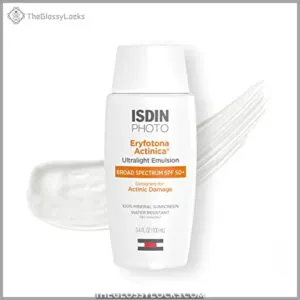
Zinc oxide forms your shield against sun damage while actively managing oil production throughout the day.
Zinc oxide: your daily defense against shine, breakouts, and UV damage in one powerful mineral.
This powerhouse mineral absorbs excess sebum, delivers anti-inflammatory benefits, and prevents breakouts without clogging pores.
You’ll notice reduced shine and calmer skin with consistent use. Look for formulas containing 9-21% zinc oxide concentration for best results.
Choose broad-spectrum protection with SPF 30 or higher for daily defense against UV rays and acne flare-ups.
Best For: People with oily, acne-prone, or sensitive skin who want strong sun protection and visible improvements in skin texture.
- Pricey compared to most sunscreens, though it lasts a long time.
- Must be shaken before use and may leave a slight residue if not blended well.
- Contains a chemical component in the inactive ingredients, which may not suit everyone.
- Non-greasy, matte finish that controls oil and reduces shine throughout the day.
- Helps prevent and calm breakouts with anti-inflammatory zinc oxide.
- Clinically proven to repair sun damage and improve skin firmness.
Creating an Effective Skincare Routine
You’ll need a structured approach that targets both excess oil production and acne-causing bacteria while maintaining your skin’s protective barrier.
The key is balancing active ingredients with gentle hydration to prevent the over-drying that actually triggers more oil production, which is crucial for maintaining gentle hydration.
Morning Skincare Routine for Oily Skin
Four essential steps transform your morning skincare routine for oily skin.
Start with gentle cleansers containing salicylic acid for oil control tips and gentle exfoliation.
Apply niacinamide serum for skin hydration without greasiness.
Follow with lightweight, non-comedogenic daily moisturizing products.
Finish with broad-spectrum SPF protection—your skin’s best defense against environmental damage and premature aging.
Using the right oily skin products is vital for effective oil control and skin balance.
Evening Skincare Routine for Oily Skin
While morning routines protect your skin, your evening routine repairs overnight damage.
Double cleansing removes makeup and sunscreen first, followed by gentle foam cleansers for oily skin.
Apply BHA exfoliants 1-3 times weekly, then niacinamide serums to calm inflammation.
Retinol application accelerates cell turnover when introduced gradually.
Finish with lightweight, non-comedogenic moisturizers for overnight hydration.
Weekly sulfur masks provide additional acne treatment benefits.
Importance of Consistency and Patience
Consistency transforms your acne skincare routine from wishful thinking into real results.
Your acne-prone skin needs time to adapt and heal, typically requiring 6-12 weeks to show meaningful improvement.
Building lasting habits requires three key elements:
- Realistic expectations – Don’t expect overnight miracles with acne treatment
- Tracking progress – Document your oily skin changes weekly
- Managing frustration – Accept that long-term benefits come gradually.
Remember, habit formation beats perfection every time.
Tips for Customizing a Skincare Routine
Skincare customization isn’t rocket science—it’s about understanding your unique needs.
Start with ingredient layering basics, then adjust product order based on your skin’s response. Consider skin cycling to prevent irritation while maintaining effectiveness.
| Factor | Oily Skin Approach | Acne-Prone Adjustment |
|---|---|---|
| Budget | Prioritize salicylic acid cleanser | Add targeted acne treatment |
| Lifestyle | Quick morning routine | Extra evening care steps |
| Sensitivity | Gradual ingredient introduction | Patch test new products |
Your skincare routine should fit your lifestyle integration needs—not the other way around.
Maintaining Healthy Oily Skin
You’ve established your skincare routine, but maintaining healthy oily skin requires avoiding pitfalls that can sabotage your progress.
These expert-backed strategies will help you keep breakouts at bay while protecting your skin’s natural barrier year-round, which is crucial for healthy skin.
Avoiding Common Mistakes in Oily Skin Care
Breaking free from common skincare blunders can transform your oily acne-prone skin journey.
Over-exfoliation dangers and harsh cleansers strip your skin’s protective barrier, triggering rebound oil production. Spot treatment overuse leads to irritation, while ignoring hydration starves your skin of moisture it desperately needs.
- Stop the picking habit – Your fingertips harbor bacteria that worsen breakouts and create lasting scars
- Ditch the "squeaky clean" mentality – Over-cleansing signals your sebaceous glands to produce even more oil
- Avoid ingredient overload – Layering too many acne treatments simultaneously causes chemical burns and inflammation
Importance of Sunscreen and UV Protection
Daily protection with broad-spectrum SPF prevents UV damage that worsens acne inflammation and creates lasting dark spots.
Chemical sunscreen ingredients can clog pores, while mineral formulas with zinc oxide offer anti-inflammatory benefits.
UV protection reduces skin cancer risk and prevents post-acne hyperpigmentation. Apply sunscreen as your final morning step, choosing oil-free, non-comedogenic products for the best results.
Tips for Minimizing Breakouts and Acne
Beyond sunscreen protection, smart habits prevent breakouts from taking control of your skincare routine oily skin.
Skip pore strips—they damage skin and worsen acne. Resist picking at blemishes, which spreads bacteria and creates scars.
Choose non-comedogenic makeup that won’t clog pores. Change pillowcases weekly to eliminate oil buildup.
Practice stress reduction through exercise or meditation, as cortisol triggers excess sebum production in acneprone skin, and maintain smart habits to improve your skincare routine.
Seasonal Adjustments for Oily Skin Care Routines
Your oily skin doesn’t need to battle the same conditions year-round.
Weather changes demand strategic product switching for ideal results.
- Summer Sebum: Switch to salicylic acid cleansers and lightweight gel moisturizers during high humidity
- Winter Hydration: Use gentle foaming cleansers with oil-free moisturizers to prevent rebound oiliness
- Humidity Control: Apply alcohol-free toners and matte sunscreens during monsoon seasons
- Seasonal Exfoliation: Increase frequency in spring (2-3 times weekly), reduce in fall
- Product Switching: Shift from antioxidant serums in fall to barrier-repair formulas in winter
Frequently Asked Questions (FAQs)
What is the 4 2 4 rule in skincare?
Studies show 60% of people over-cleanse their skin, yet the 4-2-4 method involves massaging cleansing oil for four minutes, cream cleanser for two minutes, then rinsing for four minutes.
The goal of this method is to achieve that perfect balance between thorough cleaning and skin protection.
What is the best skincare product for acne oily skin?
Salicylic acid stands as your ultimate weapon against acne’s grip.
This BHA penetrates pores deeply, dissolving oil buildup while preventing future breakouts.
You’ll find freedom combining it with niacinamide for balanced, clear skin, using salicylic acid as the key to unlock this benefit.
How to fix acne prone oily skin?
Think of your skin as a rebellious teenager—it’s acting out, but with the right approach, you can restore harmony.
Use gentle cleansers with salicylic acid, apply niacinamide serums, moisturize daily, and never skip sunscreen for clear results.
What is best for oily skin with acne?
You’ll need targeted ingredients that tackle both excess oil and breakouts. Use salicylic acid for pore-clearing, niacinamide for oil regulation, and gentle hydration to prevent overproduction cycles.
What is the order of skincare routine for oily skin?
Morning routine: cleanse, tone, apply serums (niacinamide), moisturize, then sunscreen. Evening: cleanse, exfoliate with BHA, use retinol, moisturize. You’ll control breakouts while maintaining your skin’s natural balance.
What should I avoid if I have oily acne-prone skin?
Avoid harsh scrubs, over-cleansing, and skipping moisturizer.
Don’t pick at breakouts, use heavy oils, or pile on multiple actives simultaneously.
Skip alcohol-based toners and comedogenic ingredients that’ll clog your pores further.
How do you skin cycle for oily acne-prone skin?
Skin cycling alternates active ingredients across four nights: retinoid night, salicylic acid night, niacinamide night, then recovery night with gentle moisturizer.
This prevents irritation while maximizing benefits for oily, acne-prone skin.
How can hormonal changes affect oily skin?
While estrogen keeps your sebaceous glands calm, fluctuating hormones during menstruation, pregnancy, or menopause trigger oil production spikes.
Your skin’s natural balance shifts, turning manageable oiliness into stubborn breakouts that defy your usual routine, due to these hormonal changes.
What role does diet play in oily skin?
Research shows dietary factors can influence your skin’s oil production through hormonal pathways. High-glycemic foods and dairy products may trigger increased sebum production, potentially worsening breakouts in susceptible individuals.
How do environmental factors influence oily skin?
Like a chameleon adapting to its surroundings, your skin responds to environmental triggers.
Humidity, weather changes, pollution, and stress levels directly influence sebum production, making your pores work overtime and potentially worsening breakouts.
Conclusion
Mastering the best skincare routine for oily acne prone skin means maintaining consistent care without over-treating your complexion.
You’ve learned that gentle cleansing, proper hydration, and targeted ingredients like salicylic acid work together to balance oil production.
Remember, your skin barrier needs protection, not punishment.
Start slowly with new products, be patient with results, and adjust seasonally.
With the right approach, you’ll achieve clearer, healthier skin that glows rather than shines.
- https://www.pers-skincare.com/en/pages/guide-care-skin-routine-care-face-skin-acne-grease
- https://banilausa.com/blogs/news/summer-skin-series-5-tips-for-controlling-oily-skin
- https://www.paiskincare.us/blogs/how-to/manage-oily-skin-acne
- https://eightsaintsskincare.com/blogs/page-eight/ready-to-banish-breakouts-for-good-here-are-acne-ingredients-that-work
- https://www.esquire.com/style/grooming/g62756209/best-moisturizers-for-oily-skin/

